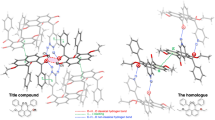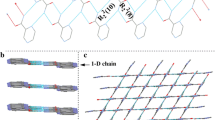Abstract
Intermolecular interactions of seven polymorphs of a model organic compound were elucidated through electronic structure-based local descriptors, derived from conceptual density functional theory, and their correlations with interaction energies. Visual and statistical analyses were conducted to inspect the underlying connections between interacting modes and electronic properties. It was found that Fukui function and Fukui potential determine interactions especially where π–π stacking is predominant in a contacting motif. The overall large regions of negative and positive values of electronic properties on interacting motifs unveil the significant correlation of the local electronic properties with the intermolecular interactions. This study further confirmed our previous reports that local softness and hardness descriptors, such as Fukui functions, are capable of characterizing the locality and strength of intermolecular interactions.







Similar content being viewed by others
References
Geerlings P, De Proft F, Langenaeker W (2003) Conceptual density functional theory. Chem Rev 103:1793–1873
Li T, Liu S, Feng S, Aubrey CE (2005) Face-integrated fukui function: understanding wettability anisotropy of molecular crystals from density functional theory. J Am Chem Soc 127:1364–1365
Liu S, Li T, Ayers PW (2009) Potentialphilicity and potentialphobicity: reactivity indicators for external potential changes from density functional reactivity theory. J Chem Phys 131:114106-6
Li T, Feng S (2005) Study of crystal packing on the solid-state reactivity of indomethacin with density functional theory. Pharm Res 22:1964–1969
Li T, Ayers PW, Liu S, Swadley MJ, Medendorp CA (2009) Crystallization force—a density functional theory concept for revealing intermolecular interactions and molecular packing in organic crystals. Chem Eur J 15:361–371
Long S, Zhou P, Theiss KL, Seigler MA, Li T (2015) Solid-state identity of 2-hydroxynicotinic acid and its polymorphism. Cryst Eng Commun 17:5195–5205
Li T, Zhou P, Mattei A (2011) Electronic origin of pyridinyl N as a better hydrogen-bonding acceptor than carbonyl O. Cryst Eng Commun 13:6356–6360
Swadley MJ, Zhou P, Li T (2015) Reactivity of triacetone triperoxide and diacetone diperoxide: insights from nuclear fukui function. Front Chem Sci Eng 9:114–123
Zhang M, Li T (2014) Intermolecular interactions in organic crystals: gaining insight from electronic structure analysis by density functional theory. Cryst Eng Commun 16:7162–7171
Mattei A, Li T (2011) Interplay between molecular conformation and intermolecular interactions in conformational polymorphism: a molecular perspective from electronic calculations of tolfenamic acid. Int J Pharm 418:179–186
Zhou P, Ayers PW, Liu S, Li T (2012) Natural orbital Fukui function and application in understanding cycloaddition reaction mechanisms. Phys Chem Chem Phys 14:9890–9896
Pearson RG (1963) Hard and soft acids and bases. J Am Chem Soc 85:3533–3539
Pearson RG (1966) Acids and bases. Science 151:172–177
Parr RG, Pearson RG (1983) Absolute hardness: companion partner to absolute electronegativity. J Am Chem Soc 105:7512–7516
Chattaraj PK, Lee H, Parr RG (1991) HSAB Principle. J Am Chem Soc 113:1856–1857
Torrent-Sucarrat M, De Proft F, Geerlings P, Ayers PW (2008) Do the local softness and hardness indicate the softest and hardest regions of a molecule? Chem Eur J 14:8652–8660
Torrent-Sucarrat M, De Proft F, Ayers PW, Geerlings P (2010) On the applicability of local softness and hardness. Phys Chem Chem Phys 12:1072–1080
Yu L, Stephenson GA, Mitchell CA, Bunnell CA, Snorek SV, Bowyer JJ, Borchardt TB, Stowell JG, Byrn SR (2000) Thermochemistry and conformational polymorphism of a hexamorphic crystal system. J Am Chem Soc 122:585–591
Mitchell CA, Yu L, Ward MD (2001) Selective nucleation and discovery of organic polymorphs through epitaxy with single crystal substrates. J Am Chem Soc 123:10830–10839
Yu L (2010) Polymorphism in molecular solids: an extraordinary system of red, orange, and yellow crystals. Acc Chem Res 43:1257–1266
Cuevas-Saavedra R, Rabi N, Ayers PW (2011) The unconstrained local hardness: an intriguing quantity, beset by problems. Phys Chem Chem Phys 13:19594–19600
Gál T (2012) Why the traditional concept of local hardness does not work? Theor Chem Acc 131:1223–1237
Chattaraj PK, Roy DR, Geerlings P, Torrent-Sucarrat M (2007) Local hardness: a critical account. Theor Chem Acc 118:923–930
Olah J, De Proft F, Veszpremi T, Geerlings P (2005) Hard–soft acid–base interactions of silylenes and germylenes. J Phys Chem A 109:1608–1615
Langenaeker W, De Proft F, Geerlings P (1995) Development of local hardness related reactivity indices: their application in a study of the SE at monosubstituted benzenes within the HSAB context. J Phys Chem 99:6424–6431
Parr RG, Yang W (1989) Density-functional theory of atoms and molecules. Oxford University Press, New York
Berkowitz M, Parr RG (1988) Molecular hardness and softness, local hardness and softness, hardness and softness kernels, and relations among these quantities. J Chem Phys 88:2554–2557
Yang W, Parr RG (1985) Hardness, softness, and the fukui function in the electronic theory of metals and catalysis. Proc Natl Acad Sci USA 82:6723–6726
Ayers PW, Levy M (2000) Perspective on “density functional approach to the frontier electron-theory of chemical reactivity”. Theor Chem Acc 103:353–360
Mignon P, Loverix S, Steyaert J, Geerlings P (2005) Influence of the π–π interaction on the hydrogen bonding capacity of stacked DNA/RNA bases. Nucleic Acids Res 33:1779–1789
Saha S, Bhattacharjee R, Roy RK (2013) Hardness potential derivatives and their relation to fukui indices. J Comput Chem 34:662–672
Cárdenas C, Tiznado W, Ayers PW, Fuentealba P (2011) The Fukui potential and the capacity of charge and the global hardness of atoms. J Phys Chem A 115:2325–2331
Allen FH (2002) The Cambridge Structural Database: a quarter of a million crystal structures and rising. Acta Crystallogr B 58:380–388
Dovesi R, Saunders VR, Roetti C, Orlando R, Zicowich-Wilson CM, Pascale B, Civalerri B, Doll K, Harrison NM, Bush IJ, Arco PD, Llunell M, Causa M, Noël Y (2014) CRYSTAL14 user’s manual. University of Torino, Torino
Frisch MJ et al (2010) Gaussian 09. Gaussian Inc., Wallingford
Thompson D, Braun J, Ford R (2000) OpenDX: paths to visualization. VIS Inc., Missoula
Hirshfeld FL (1977) Bonded-atom fragments for describing molecular charge densities. Theor Chim Acta 44:129–138
Grimme S (2006) Semiempirical hybrid density functional with perturbative second-order correlation. J Chem Phys 124:034108-15
Schwabe T, Grimme S (2007) Double-hybrid density functionals with long-range dispersion corrections: higher accuracy and extended applicability. Phys Chem Chem Phys 9:3397–3406
Beran Gregory JO (2016) Modeling polymorphic molecular crystals with electronic structure theory. Chem Rev 116:5567–5613
Boys SF, Bernardi F (1970) The calculation of small molecular interactions by the differences of separate total energies. some procedures with reduced errors. Mol Phys 19:553–566
Bartolotti LJ, Ayers PW (2005) An example where orbital relaxation is an important contribution to the Fukui Function. J Phys Chem A 109:1146–1151
Acknowledgements
This research was supported by National Science Foundation (NSF) and Chao Endowment Fund.
Author information
Authors and Affiliations
Corresponding author
Additional information
Publisher's Note
Springer Nature remains neutral with regard to jurisdictional claims in published maps and institutional affiliations.
Published as part of the special collection of articles derived from the Chemical Concepts from Theory and Computation.
Electronic supplementary material
Below is the link to the electronic supplementary material.
Rights and permissions
About this article
Cite this article
Bhattacharjee, R., Verma, K., Zhang, M. et al. Locality and strength of intermolecular interactions in organic crystals: using conceptual density functional theory (CDFT) to characterize a highly polymorphic system. Theor Chem Acc 138, 121 (2019). https://doi.org/10.1007/s00214-019-2508-0
Received:
Accepted:
Published:
DOI: https://doi.org/10.1007/s00214-019-2508-0




